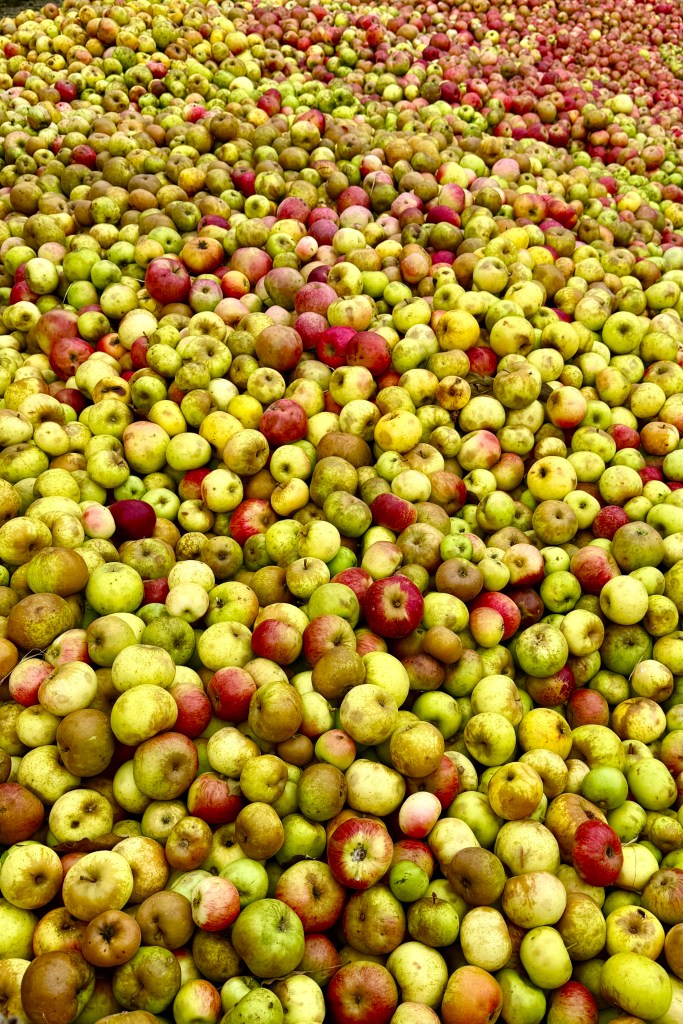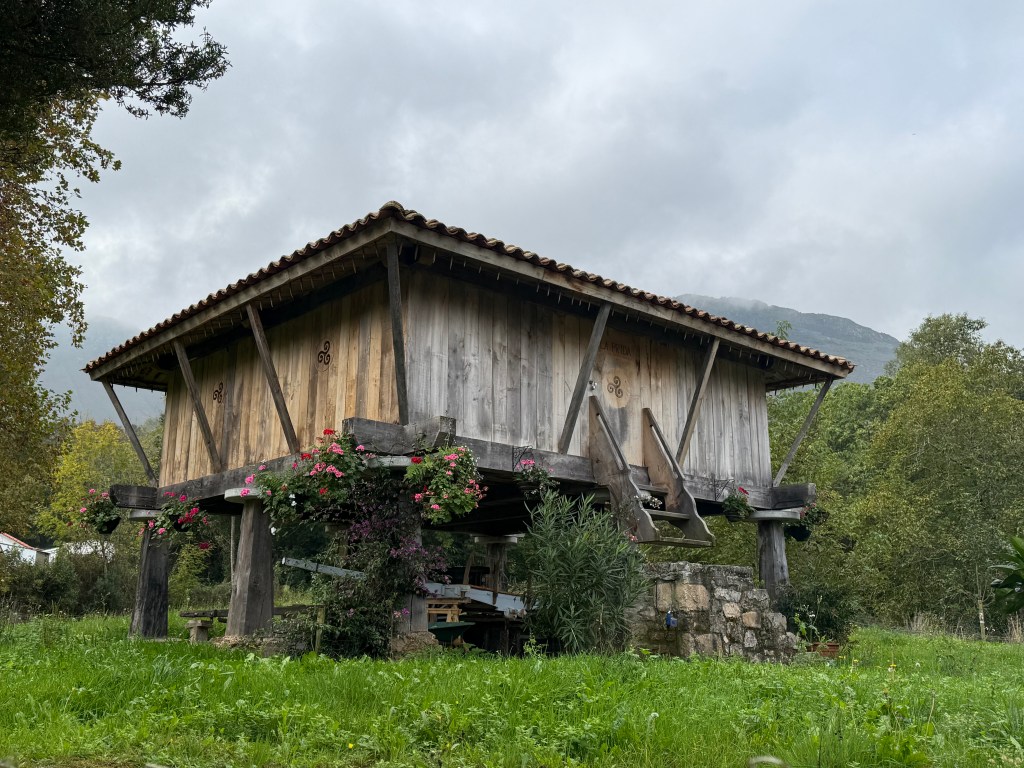Along the Camín Encantáu: From Forest Fire to Fairy Tales (and Cachopo)
Along the Camín Encantáu: From Forest Fire to Fairy Tales (and Cachopo)
By David Eugene Perry / Photos by Alfredo Casuso
Part of our continuing exploration of off-the-beaten-path Spain
15 October 2025 — We didn’t set out to be enchanted. That’s the thing about enchantment: it finds you. One moment, you’re brushing dew off your boots in a sleepy coastal village. The next, you’re reporting a forest fire, stumbling across carved goblins in the trees, and ending the day in front of a cachopo the size of a cathedral bell.
As we drove out of Llanes, we passed the ethereal Church of Nuestra Señora de los Dolores in Niembro. It was low tide, and for all the world, it reminded me of a mini Mont Saint-Michel. At high tide, however, it’s quite different. They call it “The Floating Church” as its cemetery appears to float. We made a note to swing back by later this trip.

About 30 minutes later, we parked next to a sandy pit, site of one of Northern Spain’s favorite sports: Bolos, kind of the Cantabrian and Asturian version of bowling.” We’re one of only two cars in the parking lot, and the sandy pit is empty, but guarded by the first of numerous wooden statues we’d end up encountering day.
l

We set off, with a tree-stumped framed chorus of “tragos” welcoming and cautioning us. Trasgos are mischievous goblin-like creatures from Asturian mythology, often playful but tricky. El Camín Encantáu is all about these mythical and mysterious denizens of the waters and woods.
Los Trasgos os dan la bienvenida a la ruta encantada. No la llaman así por nada. Está repleta de sorpresas, unas más agradables que otras. Así que tened los ojos bien abiertos y no os salgáis del camino.
The Trasgos welcome you to the enchanted trail. It’s not called that for nothing. It’s full of surprises—some more pleasant than others. So keep your eyes wide open and don’t stray from the path.
At the end of this blog, we’ll list each “creature” in the order we encountered them.

The path is well marked and the initial climb isn’t strenuous, but pleasantly challenging. Even non-veteran senderistas would be fine. The trail reveals scenery that would challenge the imaginations of A.A. Milne, C.S. Lewis, and Tolkien. As if the Hundred Acre Wood met Narnia for a picnic in Middle Earth. Outside farmhouses, heaps of apples waited to become cider.

Fields of corn frame what have to be the happiest (and prettiest) cows on Earth.

Chapels of stone and mini-churches made from toys and twigs kept us company.

Everywhere are examples of the classic rural storage huts known as hórreos (or paneras). These are traditional granaries built to store crops like corn, keeping them safe from moisture and pests. They are raised on pillars, often topped with flat stones called vira-ratos, to prevent rodents from entering. These unique structures are a significant part of the region’s rural architecture and heritage. We saw one beautifully restored that made me think “Mmmm…a very nice writing tower that would make.”

Within minutes of our initial ascent, Alfredo spotted an orange in the mountains beyond: a burgeoning woodland blaze. Ever resourceful, he dial “119” – the number to report a forest fire. Promptly a “real person” answered and Alfredo made his report (my hero, and now others).
About half-way through, we came across the charming hamlet of Palacio where we stopped for coffee. The local doyenne reminded me so much of my late Grandma that I decided it was a good luck sign, so we bought a “Gordo”: the traditional Spanish national lottery ticket whose winning number is revealed at Christmas. Most every bar in Spain has their own number, and people buy a “piece” of the number.
Three hours later almost to the minute, we were back from whence we set off. We were tired and hungry, and looking forward to a lunch of one of Asturia’s treasure culinary treats: Cachopo at Sidrería Casa El Rubiu in the town of Vidigao, nearby our base in Llanes. Supposedly home of “the best cachopo in Asturias” (which means by default “in the world”, the restaurant doesn’t take reservations so we showed up at 12:45pm, when they take the rope off the front entrance. Note: the cachopo is only served to two people (it’s BIG and rich). Trust us — three would be quite happy. A digestive siesta was required after what was a meal that I’m sure ate up all of our previously burned calories. Yum!

And so, another awesome Asturian amble was at an end: an exercise in enchantment, as the route’s name implies. Oh, a wonderful postscript: as we finished out walk, we say a a truck load of “bomberos” (fireman) heading away from the area where Alfredo reported a blaze. I’m sure out little fairy-like guardians of the forest were pleased with our intervention.
Besides the natural scenery, all along our route we encountered carved and painted wooden statues of figures from Asturian mythology. Each comes with a plaque and a personality. Below is the full list as we encountered them.
# 1 El Sumiciu

Dicen que no existo. Pero cuando desaparece algo se acuerdan de mí. Mira bien en tus bolsillos antes de seguir tu camino, no acepto reclamaciones. Además, no existo… ¿O sí?
They say I don’t exist. But when something disappears, they remember me. Look carefully in your pockets before continuing your journey, I don’t accept complaints. Besides, I don’t exist… Or do I?
# 2 El Hombre del Saco (The Sack Man), a figure from folklore often used to scare children into good behavior.

¿Te asusté? No, claro que no. De día sois todos muy valientes. Ni al hombre del saco le teméis. Pero en estos bosques es fácil perderse, y no soy yo el más temble que vas a encontrar.
Did I scare you? No, of course not. During the day, you are all very brave. You don’t even fear the Sack Man. But in these woods, it’s easy to get lost, and I’m not the most frightening thing you’ll encounter.
# 3 “El Pataricu”

Soy el Pataricu. Puede que solo tenga un ojo, pero te llevo vigilando desde que llegaste. Dicen que me alimento de niños pero es mentira, solo el día de mi cumpleaños. ¿Adivinas qué día es hoy?
I am the Pataricu. I may only have one eye, but I’ve been watching you since you arrived. They say I feed on children, but that’s a lie, only on my birthday. Can you guess what day it is today?
# 4 Dianu Burlón

Soy el Dianu Burlón y nunca podrán atraparme. Ni los romanos pudieron, y esos sí eran listos, no como tú. Puedo cambiar de forma y engañarte para que hagas lo que yo quiera. Ay, qué tontos sois los humanos.
I am the Dianu Burlón and no one will ever catch me. Not even the Romans could, and they were clever, not like you. I can change shape and trick you into doing what I want. Oh, how foolish you humans are.
# 5 El Nubéru

Soy el Nubéru. Yo mando sobre la lluvia y los vientos. El relámpago es mi látigo y el trueno mi voz. ¿Quieres llegar seco al final del camino? Pues respeta la naturaleza o tendrás que enfadarme.
I am the Nubéru. I command the rain and the winds. The lightning is my whip and the thunder my voice. Do you want to arrive dry at the end of the path? Then respect nature, or you will have to anger me.
# 6 La Xana de Teves (a water nymph of rivers, streams and fountains)

Dicen que el oro ciega, pero si te acercas a mi fuente, quizás te deje ver un poquito de lo que de verdad brilla.
They say gold blinds, but if you come close to my spring, perhaps I’ll let you see a little of what truly shines.
# 7 El Segador (The Reaper)

Aquí hasta las guadañas están vivas. Y si no cuidas de ellas, ellas dejan de ayudarte.
Here even the scythes are alive. And if you don’t take care of them, they will stop helping you.
# 8 El Cuélebre

Soy el Cuélebre, la serpiente alada que custodia tesoros y princesas. ¿Quieres llevarte un tesoro o la princesa? Puedes intentarlo, pero ya me he comido a muchos valientes como tú en los últimos tres mil años.
I am the Cuélebre, the winged serpent that guards treasures and princesses. Do you want to take a treasure or the princess? You can try, but I’ve already eaten many brave ones like you in the last three thousand years.
# 9 La Llavandera (the washer woman)

Si me ves es que las malas noticias no tardarán en llegar. Hoy seré buena contigo, pero otra vez me oyes cantar mientras lavo la ropa mejor échate a correr.
If you see me, it means bad news won’t be long in coming. Today I’ll be kind to you, but another time when you hear me singing while I wash the clothes, you’d better run.
# 10 El Busgosu (sadly, this statue was “missing”, perhaps for repair)

Soy el Busgosu, amo y señor de los bosques. Soy tan viejo como el musgo y tan astuto como las criaturas que aquí habitan y los cazadores que aquí aguardan. Las piedras te ayudarán a salir de este bosque si te has perdido. ¿Crees que te han traicionado? ¡Lo has hecho!
I am the Busgosu, master and lord of the forests. I am as old as the moss and as cunning as the creatures that live here and the hunters that wait here. The stones will help you get out of this forest if you are lost. Do you think they have betrayed you? You have!
# 11 Manona

Qué se detengan los que respetan la naturaleza ni sus voces. Qué contienen su mundo oculto y seres mágicos.
Let those who respect nature and its voices stop. They contain a hidden world and magical beings.
# 12 Castañera

¿Habéis disfrutado de la ruta? Os vendrán bien unas nueces reconfortantes y castañas, verdad? Y a mi no ser de madera, no te digo.
Have you enjoyed the route? Some comforting nuts and chestnuts will do you good, right? And since I’m not made of wood, I won’t tell you.
The area around Llanes, Asturias is a hiker’s dream with something for every level of walker. And, of course, the famed Camino de Santiago runs along its coast and inland areas. To lean more, go online to the very well-done website https://www.llanes.es/en/route/el-camin-encantau